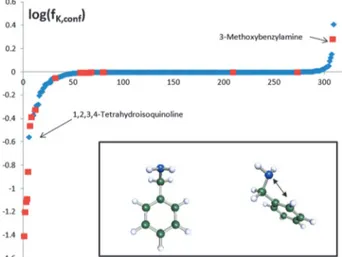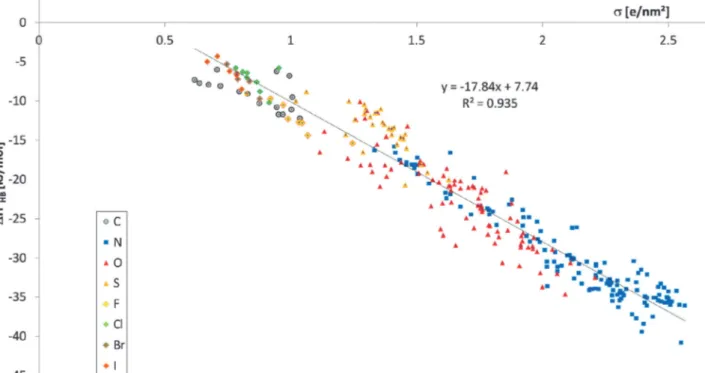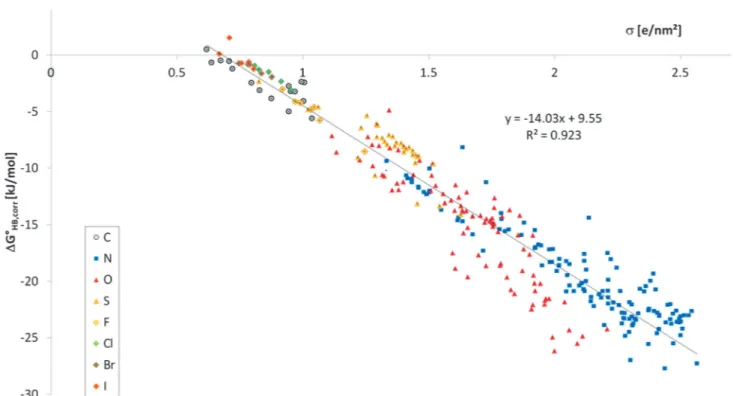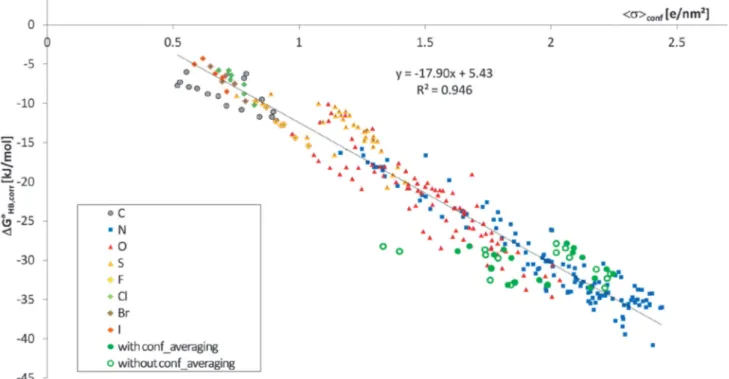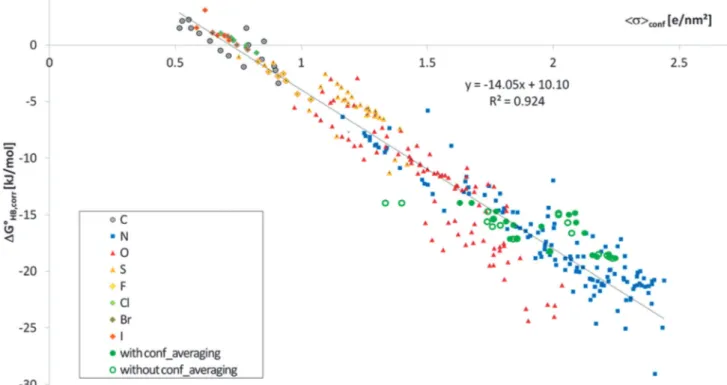Cite this:Phys. Chem. Chem. Phys.,2013, 15, 7147
Interpretation of experimental hydrogen-bond enthalpies and entropies from COSMO polarisation charge densities†
Andreas Klamt,*abJens Reinisch,aFrank Eckert,aJe´roˆme Gratoncand Jean-Yves Le Questel*c
In this work, experimental hydrogen-bond (HB) enthalpies measured in previous works for a wide range of acceptor molecules in dilute mixtures of 4-fluorophenol in non-polar solvents are quantified from COSMO polarisation charge densitiessof HB acceptors (HBA). As well as previously demonstrated for quantum chemically calculated HB enthalpies, a good correlation of the experimental data with the polarisation charge densities is observed, covering an extended range of HBA (O, N, S,psystems and halogens) ranging from very weak to strong hydrogen bonds. Furthermore, for the first time, a quantitative analysis of experimental HB entropies is performed for such a chemical diversity of HBA.
A good quantification of these entropies is achieved using the polarisation charge density s as a descriptor in combination with the logarithm of a directional partition function OHB. This partition function covers the directional and multiplicity entropy of HBA and is based on thes-proportional HB enthalpy expression taken from COSMO-RS. As a result, the experimental HB enthalpies and free energies of theB300 HB complexes are quantified with an accuracy ofB2 kJ mol1based on COSMO polarisation charge densities.
Introduction
The hydrogen bond (HB) is recognised as the most important specific interaction between a molecule and its local environ- ment. However, there is a tendency to view hydrogen-bond acceptors (HBA) and donors (HBD) as atomic sites and to consider them equivalent despite that the effects of organic functions and substituents that define the local molecular environ- ment can have huge impacts on their HB properties. Indeed, although HBs are qualitatively well understood, it is generally admitted that quantitative data are needed. From an experimental point of view, the quantification of HB energy is complicated because a hydrogen bond can never be studied individually,
its formation going unavoidably along with the concomitant dispersion and electrostatic contributions.
The situation is even worse in solution, since the formation of a hydrogen bond in this case additionally requires the removal of the solvent molecules in interaction with the acceptor prior to the HB formation. If the solvent molecules are not completely isotropic with respect to their electrostatics, or if they even have their own polar hydrogen atoms, i.e. their own prospective HBD site, the estimation of the free energy needed for removing the solvent at the position of the acceptor (desolvation) even requires statistical thermodynamics for getting appropriate averages.
The importance of hydrogen-bonding and the need of quantitative parameters for a comprehensive understanding and description of the interaction has led several research groups to concentrate their efforts in the construction of HB basicity scales, called pKHB,1 log Kb,2 Sb2H,3,4 SCa5,6 or B.7 Following the pioneering work of Taft and coworkers,1Laurence et al.8reported recently the development of the pKBHXdatabase, which contains an unprecedented set of experimental values related to HB basicity. More precisely, HB free energies have been determined in tetrachloromethane (CCl4) for a large number of chemically diverse HBA molecules usingp-fluorophenol (pFP) as
aCOSMOlogic GmbH&CoKG, Burscheider Str. 515, 51381 Leverkusen, Germany.
E-mail: klamt@cosmologic.de; Tel:+49 2171 731681
bInstitute of Physical and Theoretical Chemistry, University of Regensburg, Germany
cChimie et Interdisciplinarite´: Synthe`se, Analyse, Mode´lisation (CEISAM), UMR CNRS 6230, Universite´ de Nantes, 2 rue de la Houssinie`re – BP 92208, 44322 Nantes Cedex 3, France. E-mail: jean-yves.le-questel@univ-nantes.fr;
Tel:+33 251125563
† Electronic supplementary information (ESI) available. See DOI: 10.1039/
c3cp44611e
Received 20th December 2012, Accepted 1st March 2013 DOI: 10.1039/c3cp44611e
www.rsc.org/pccp
PAPER
Published on 22 March 2013. Downloaded by Universitaetsbibliothek Regensburg on 04/08/2016 12:13:08.
View Article Online
View Journal | View Issue
the reference HBD, chosen for historical and technical reasons.1,9 The measurements are made following the standard procedure based on the absorbance decrease in the OH absorption ofpFP (n(OH) = 3614 cm1;e= 237 dm3mol1cm1) in dilute ternary pFP–base–CCl4solutions at 251C, leading to pKBHXvalues. More precisely, typical concentrations of 3–4 mM are prepared for our reference donor (pFP) and of 10–300 mM for the acceptors, depending on their HB basicity. Although contaminated to some degree with local desolvation and electrostatic contributions, the HB free energy is estimated from the equilibrium constants of complex association as –RT lnK, or equivalently as –RT pKBHX/ln 10. Using this notation, a strong HB acceptor forming a hydrogen-bonded complex with a large association constant (K), that is a low dissociation constant (KBHX= 1/K), has a large positive value of pKBHX. This can be reasonably justified based on the aprotic nature of CCl4, its high degree of isotropy with respect to polarity, and the use of a reference HBD. In its present version, the pKBHXdatabase contains about 1340 values corresponding to nearly 1200 HBA. Furthermore, the HB enthalpies towards pFP for about 310 varied organic bases, ranging over 40 kJ mol1, have been published,10providing, in addition to the HB free energies, the quantitative establishment of the order of HB enthalpies according to a given atomic acceptor site. More exactly, this order of HB enthalpies has even been established according to the chemical function to which belongs the studied atomic site. These values have been measured from the temperature dependence determinations of the complex equilibrium constants. For this energetically extended and chemically diversified set of acceptors, the HB free energy was split into its enthalpic and entropic contributions. To our knowledge, this work is therefore the most extensive homo- geneous experimental study of the thermodynamics of hydrogen bonding that has been carried out so far.
From a theoretical perspective various attempts have been presented aiming for a predictive quantification of hydrogen- bond strength. Most often the HBD and HBA strength para- meters used as experimental basis are Abraham’s ones.2–4 Beyond more empirical increment schemes11quantum chemical descriptors have been used for a correlation of HB strength.
Kenny12used the electrostatic potential as a quantum chemical descriptor for HBA strength of nitrogen bases. Schwo¨bel and coworkers13–16presented several studies, in which they demon- strate the suitability of local frontier orbital descriptors17for the predictive quantification of Abraham’s HBA and HBD parameters of a chemically much broader range of donor and acceptor sites.
Klamt et al.18 recently presented a detailed study on HB enthalpies calculated quantum chemically for 2465 donor acceptor pairs. For reflecting the situation in a solvent, solva- tion effects were considered in the extreme limit of a perfect conductor employing the COSMO continuum solvation model.19 On a very large and chemically very diverse set ofB2500 donor–
acceptor complexes, they demonstrated that the quantum chemically calculated HB enthalpies can be quantified with an accuracy ofB1.3 kJ mol1assuming a bilinear dependence on the COSMO polarisation charge densitiessdonandsacc. The COSMO polarisation charge density is the local surface density of
the conductor screening charges,i.e.the screening charge per unit area of the cavity surface, as resulting from the conductor- boundary conditions in the continuum solvation model (COSMO).
The suitability of the polarisation charge density for the quanti- fication of intermolecular interaction has been demonstrated by Klamt in his COSMO-RS solvation model.20–22 For those not familiar with the concept of COSMO, a more detailed description and discussion of the polarisation charge densitys is given in appendix SI1 in the ESI.† The study on the quantum chemically calculated HB complexes confirmed the bilinears-dependence of HB bond energies assumed within the COSMO-RS.
In this paper we demonstrate that the described linearity of HB energies with respect to sacc does not only hold for the calculated HB energies, but also for the experimental HB enthalpies reported by Laurenceet al.10An analysis of the HB free energy with respect to sacc clearly discloses that the directional HB entropy has an important influence. Further- more, we introduce a directional HB partition function which allows for the quantification of this directional entropy without any additional adjusted parameter.
Data sets and calculation methods
For the sake of consistency, we will only consider in this paper the 309 HBA molecules for which HB enthalpiesDHoHBand HB free energies DGoHB with pFP in CCl4 or tetrachloroethylene (C2Cl4) have been reported by Laurenceet al.10in the core and in the supplementary data of their paper. Some compounds (e.g. amines) are known to react with CCl4, and the corre- sponding measurements were therefore made in C2Cl4, which is very similar to CCl4, in particular with respect to polarity. The differences between the HB data obtained in the two solvents have indeed been shown to be small and no systematic differ- ences were observed.23
For all compounds, DFT/COSMO calculations have been performed with the TURBOMOLE program24at the BP-TZVPD/
COSMO level,25–30 as described in ref. 18. A conformational analysis following the concepts of COSMOconf workflow31was performed for each of the acceptor molecules. For each atom the maximum of the locally averaged polarisation charge density s was calculated with the COSMOtherm program32 according to eqn (11) of ref. 21. Since negatively polar HBAs need to have positives-values, the atom with the maximum s-value,i.e.the most polar acceptor, was selected as the HBA of interest in the case of polyfunctional molecules, bearing several HBAs. Actually, these theoretical assignments disagreed from those assumed in the experimental work only in one case, which will be discussed below.
While in the previous study on the s-dependence of QM/COSMO calculated HB enthalpies the molecular conforma- tion was known for each donor and acceptor under considera- tion, the comparison with experimental HB enthalpies and free energies bears the complication that for some of the more flexible acceptors, the exact or predominant conformation in the solvent is not known from experiment. The most relevant conformation for hydrogen bonding may even be, in some cases,
Published on 22 March 2013. Downloaded by Universitaetsbibliothek Regensburg on 04/08/2016 12:13:08.
different from the predominant conformation in the solvent.
To appropriately deal with such conformational ambiguities, we carried out a COSMO-RS study of the complex formation constants by calculating the contact probability of the dilute acceptor molecules and dilutepFP molecules in CCl4with the COSMOtherm program.32 At first, that calculation was per- formed for the entire conformational set, yielding, aside of the conformationally averaged contact probability, the popula- tion of the individual conformations in CCl4. Then we repeated the calculation of the complex formation constant only taking into account the most populated conformation in CCl4. The ratio fK,conf of the calculated complex formation constants without and with conformational multiplicity was calculated and is reported in Table SI1 in the ESI.† As shown in Fig. 1, for most of the considered acceptors the complex formation con- stant is rather insensitive to the conformational multiplicity.
Only for seven compounds we found log(fK,conf) to be lower than 0.4, all of them being benzylamines, except 1,2,3,4-tetra- hydroisoquinoline, the extreme value being3.2 log-units for 3-(trifluoromethyl)benzylamine. For these molecules, our calculations show that the lowest energy conformation in CCl4
is much less involved in HB interactions than the other con- formations. A closer investigation showed that this behaviour is due to the formation of a 5-membered ring stabilized by a weak intramolecular interaction of the slightly positiveortho-hydrogen with the amine lone pair, shown in the right inset in Fig. 1. On that basis, the 18 amines having the same 5-membered ring structure in their lowest energy conformer in CCl4 have been removed from our sample. Being a single exception, we kept 1,2,3,4-tetrahydroisoquinoline in the data set. For all com- pounds with |log(fK,conf)| less than 0.4, we estimate that the potential error resulting from the neglect of additional
conformations on the free energies of HB formation should be smaller thanB2 kJ mol1.
For two very bulky tertiary amine compounds (N,N-diiso- propyl-3-pentylamine and N,N-diisopropylisobutylamine) a more serious problem occurred. In all conformations generated by COSMOconf the amine lone-pair was entirely hidden by the bulky substituents. No surface area with sufficiently highsfor hydrogen bonding was found. Even manual attempts to generate the conformations with the accessible amine lone- pair failed, since the quantum chemical energies of these conformations were too high in order to be relevant. These theoretical trends agree well with the experimental behaviour observed for tertiary amines33for which the nitrogen is hidden by long and/or branched alkyl chains. Consistently, these two compounds have also been removed from our analysis dataset, which finally consisted of 289 acceptor molecules.
Results and discussion
As the first step of our analysis, we plotted the experimental HB enthalpy DHoHBvs. the polarisation charge density sacc of the strongest acceptor position, as shown in Fig. 2. A linear depen- dence can clearly be observed. This relationship is characterised by a correlation coefficientr2of 0.935, and a standard deviation of 2.4 kJ mol1with a rather homogeneous error distribution. Hence, we may conclude as a first result that the HB enthalpies measured in CCl4 confirm the assumption of s-proportionality of the HB enthalpy as suggested in our previous theoretical study.18
Next, we considered the analogous plot for the experimental HB free energyDGoHB, as shown in Fig. 3. TheDGoHBdata are the primary results of the equilibrium constant determination while the enthalpies are derived from the van’t Hoff plot established with the equilibrium constants measured on a range of 60 1C, from 5 1C to 55 1C. For this reason, the experimental error is found to be smaller forDGoHB(0.2 kJ mol1) than for DHoHB (1 kJ mol1). However, despite the higher experimental accuracy forDGoHB, the correlation with the polari- sation charge densitysacc, withr2= 0.729 ands= 3.0 kJ mol1, is much worse than the corresponding one found for DHoHB. This is not really unexpected since the entropic contribution arising from site and lone-pair multiplicity, from the degree of directional softness and from the vibrational changes arising from the deep and narrow potential energy minima typical for HB cannot be assumed to be simply proportional tosacc. After a closer analysis of the deviations from the regression line, it turns out that the s-regression strongly underestimatesDGoHB
for exposed oxygen atoms, the extreme case corresponding to hexamethylphosphoramide, while on the upper side of the regression line theDGoHBobtained are in contrast overestimated for sterically hindered acceptor atoms such as tertiary amine nitrogens. This observation highlights the need of a quantita- tive measure of the directional entropy,i.e. of the number of almost equivalent positions on the molecular surface at which the hydrogen bond can be formed, in the HB free energy.
The entropic contribution arising from the multiplicity is to some extent already taken into account in the experimental data,
Fig. 1 Conformational sensitivity of the calculated complex formation constant.
The 309 compounds are ordered with respect to the ratiofK,confof the donor–
acceptor contact probability calculated without and with conformational multi- plicity. The red symbols mark the compounds removed from the sample (see the text). The inset illustrates the preferred conformation of benzylamine in polar solvents with an exposed nitrogen lone-pair, and the preferred conformation in a non-polar solvent as CCl4, in which the nitrogen lone-pair interacts with anortho- hydrogen atom and thus is less available for hydrogen bonding.
Published on 22 March 2013. Downloaded by Universitaetsbibliothek Regensburg on 04/08/2016 12:13:08.
since the entropic valuesDSoare statistically corrected by a R ln(n) term, where n is the number of (quasi)-equivalent sites, in order to put these values on a per acceptor atom basis.
However, some cases have been trickier to handle. Thus, the aromatic bases have been treated considering one benzene ring as a single HBA. In the same vein, for molecular systems
bearing two HBAs in close spatial proximity (e.g. syn-2,4-difluoro- adamantane) the experimental values refer to one HBA site, based on the experimental and theoretical evidence of bifurcated (three-centre) HB interactions in these cases.34Lastly, in the case of polyfunctional bases, experimental arguments have been used as guides for the statistical correction to apply. For example,
Fig. 3 Experimental HB free energies,DGoHB, of 289 acceptor molecules plottedvs.the COSMO polarisation charge densitysaccof the most polar acceptor position.
Fig. 2 Experimental HB enthalpies,DHoHB, of 289 acceptor molecules plottedvs.the COSMO polarisation charge densitysaccof the most polar acceptor position.
Published on 22 March 2013. Downloaded by Universitaetsbibliothek Regensburg on 04/08/2016 12:13:08.
in the case of triethylthiophosphate, which possesses three oxygen and one sulphur atoms as potential HBAs, we have considered the sulphur atom as the only HBA site, based on a previous experimental investigation.35This last assignment is in contradiction with the trends obtained from the computed polarisation charge densitiessacc, since the three oxygen atoms are found to be the strongest HBA sites.
These various situations have led us to the decision to return to the unbiased originalDGo values for the entire sample of molecules, and to calculate the full HB directional and multi- plicity entropic correction by a HB partition function, evaluated over the entire molecular surface. Based on the assumption of s-proportional HB enthalpy, and using the slope of the regres- sion line in Fig. 1 as a reasonable guess for the dependence of the local HB enthalpy on sacc, we thus constructed a HB partition functionOHB and the respective entropy descriptor SHB dirmult=Rln(OHB), which is expected to capture this missing entropic contributions. For details of the calculation ofOHBsee Appendix 1. As a side product, this partition function also gives us an expectation valuehsacciwhich should be a better measure for the enthalpy than the maximum value.
As can be seen in Fig. 4, the correlation between the experi- mentally reported DGoHB values, corrected by –RT ln(OHB), and saccis strongly improved (r2= 0.923 ands= 2.1 kJ mol1). This goes along with a significant change in the slope of the regres- sion line. We attribute this to the fact that the directional entropy is to some degree correlated withsacc. This is because the nitrogen acceptors, and especially the tertiary amines, have the highest values ofsacc, but very small exposed surface area available for the single lone-pair, while oxygen acceptors typically
have smaller values ofsaccand two lone-pairs,i.e.larger HB area.
Finally, the very weak halogen andp-acceptors have small sacc values but a large accessible surface for complexation of quite similars,i.e.a large directional entropy.
If we replace the maximum of the acceptor polarisation charge density, so far denoted sacc, by the expectation value hsacci, and replace the reference s in the partition function accordingly, then the statistics does not change, i.e. we still have r2 = 0.923 and s = 2.1 kJ mol1. But if we replace the descriptorsaccbyhsacciin the enthalpy correlation, i.e.in an analogue of Fig. 1, the correlation improves tor2= 0.945 and s = 2.2 kJ mol1, while the slope of the regression is almost unaffected. Hence, overall, the hydrogen-bond expectation valuehsacciseems to be the slightly better descriptor, but from a practical perspective the local maximum value sacc is more readily available.
Going a next step toward thermodynamic consistency, we can calculate the partition functions and expectation values taking into account multiple conformations of the acceptor.
This requires the knowledge of the conformational population wiof each conformationi. If we use the COSMO-RS model in its COSMOtherm implementation, we get estimates of these con- formational populations in the solvent. Based on these we can easily get the respective HB partition functions OHB,conf and expectation valueshsacciconf. Inserting these values we end up with a tiny improvement for the HB enthalpy regression (r2= 0.946, s = 2.2 kJ mol1; see Fig. 4) and also for the HB free energy regression (r2= 0.924,s= 2.1 kJ mol1; see Fig. 5). Since we had already excluded the 18 compounds showing conforma- tional preferences with specific intramolecular interactions,
Fig. 4 HB free energies,DGoHB,corr, corrected from the directional and multiplicity entropy contributions of 289 acceptor molecules plottedvs.the COSMO polarisation charge densitysacc.
Published on 22 March 2013. Downloaded by Universitaetsbibliothek Regensburg on 04/08/2016 12:13:08.
it is not surprising that the improvement in this dataset is small. But, as shown in Fig. 5 and 6, these 18 HBAs are now described with the same quality as the other compounds using the conformationally averaged quantities.
Based on the two regressions (in units of e nm2forsand kJ mol1for energy)
DHoHB=17.9hsacci+ 5.4 (1) and
DGoHB=14.1hsacci+ 10.1RT ln(OHB) (2) we yield
DSoHB= (DHoHBDGoHB)/298 K =3.8hsacci/298 K4.7/298 K +Rln(OHB) (3) Hence the HB entropy consists of an acceptor independent negative constant, a directional and multiplicity contribution and a majors-proportional entropy loss. The latter can be easily interpreted by the deeper and thus more narrow minimum on the molecular potential energy surface with increasing HB enthalpy, and hence with increasingsacc.
It might be worth noting that thes-slope of the HB enthalpies found here,i.e.the value of 17.9 kJ mol1nm2e1, is only 63% of thes-slope of the regression line found in eqn (1) in the study on quantum chemically calculated HB enthalpies in a conductor environment18for a donor ofsdon= 2.0,i.e.using the value found on the donor hydrogen atom ofpFP. Hence, in a conductor, the hydrogen bonds would be roughly 50% stronger than in CCl4. This is not surprising given the stronger
polarisation of the donor and acceptor molecules in a conduc- tor compared with the non-polar CCl4environment used here.
Indeed, this is in quite good agreement with the fact that the polarisation charge densities in a non-polar solvent typically are by a factor of 0.8 smaller than in a conductor, due to the almost complete lack of electronic back-polarisation in non-polar solvents.36Since we are using as descriptorssvalues calculated in a conductor environment here, and since this reduction applies to the donor and acceptor, we would expect a reduction of the slope ofDHoHB,vs.sby a factor ofB0.82= 64%.
Summary and conclusions
Experimental HB free energies and enthalpies measured in CCl4
for a wide and varied selection of HB bases have been analysed from COSMO polarisation charge densitiessaccof the acceptor atoms. The HB enthalpies show a strong correlation withsacc withr2= 0.94 and a standard deviation ofB2 kJ mol1. Based on the observed s-proportionality of the HB enthalpies, partition functions have been constructed for the molecular free energy of hydrogen bonding. Using these partition functions for the description of the directional and multiplicity entropy of hydrogen bonding, the HB free energy can as well be described as a linear function ofsaccwith almost the same correlation coefficient and standard deviation. The lower slope of the HB free energy s-regression compared to the HB enthalpy regression corre- sponds to as-proportional part of the HB entropy.
The relations presented herein between experimental HB enthalpies or free energies and the COSMO polarisation charge
Fig. 5 Experimental HB enthalpies,DHoHB, of the 307 HBA molecules (289 + 18) plottedvs.the HB expectation value of the COSMO polarisation charge density hsacciconf. The full green symbols mark the 18 conformational problematic cases (mainly benzylamines). For comparison, open green symbols mark these compounds before conformational averaging.
Published on 22 March 2013. Downloaded by Universitaetsbibliothek Regensburg on 04/08/2016 12:13:08.
densities s, established for an unprecedented chemically diverse sample, can be used for the prediction of HB enthalpies and free energies of compounds for which experimental data are not available or even not experimentally accessible,e.g.in the case of multiple competing HB acceptors.
From a theoretical point of view the results present for the first time a quantitative model for the HB entropy in solution.
This model demonstrates that entropy contributions arising from the directional flexibility are of comparable importance as the entropy loss which arises from the vibrational restriction of the HB length, which increases proportionally to the HB strength. This quantitative insight into the different contribu- tions of the HB entropy can be useful for improvements of the HB expressions in solvation models as COSMO-RS, but also for force field improvements.
Appendix 1: construction of the HB partition function
If we assume that every surface segmentnwith surface areaanand polarisation charge densitysncan form a hydrogen bond of enthalpy
hnhb=chbsdonsn (A1) with a hydrogen bond donor of polarisation charge density sdon, then the relative partition function of hydrogen bonding compared to a reference is
Oahb;conf¼ahb1X
i
waiX
n2a
anexp chbsdonðsnsrefÞ RT
(A2)
where the n summation is over all surface segments of a moleculea, andsrefcan be either the maximum value ofsacc on the acceptor molecule, or its expectation value according to eqn (A3). The i summation is over the conformations of moleculea, wherewai is the relative conformational population of conformationi. In the case of just one conformation it is unity.ahb is the effective hydrogen bond contact area, which has a value of 4.57 Å in the parameterisation used here.
In our case of hydrogen bonds with a fixed donor (pFP) in a fixed solvent (CCl4) the value ofchbsdoncan be taken from the slope of the HB enthalpy with respect tosacc,i.e.from the slope of the regression line in Fig. 1.
The expectation value of the hydrogen bondsaccarising from the multiple directional choices of the HB and potentially from multiple HB sites on the acceptor surface consequently is given as
sacc h iconf
¼ahb1X
i
waiX
n2a
snanexp chbsdonðsnsrefÞ RT
,
Oahb;conf (A3)
References
1 R. W. Taft, D. Gurka, L. Joris, P. v. R. Schleyer and J. W. Rakshys,J. Am. Chem. Soc., 1969,91, 4801–4808.
2 M. H. Abraham, P. P. Duce, D. V. Prior, D. G. Barratt, J. J. Morris and P. J. Taylor,J. Chem. Soc., Perkin Trans. 2, 1989, 1355–1375.
Fig. 6 Experimental HB free energies,DGoHB,corr, of the 307 HBA molecules (289 + 18) corrected for the conformationally averaged HB partition function plottedvs.
the HB expectation value of the COSMO polarisation charge densityhsacciconf. The full green symbols mark the 18 conformational problematic cases (mainly benzylamines). For comparison, open green symbols mark these compounds without conformational averaging.
Published on 22 March 2013. Downloaded by Universitaetsbibliothek Regensburg on 04/08/2016 12:13:08.
3 M. H. Abraham, P. L. Grellier, D. V. Prior, J. J.
Morris and P. J. Taylor, J. Chem. Soc., Perkin Trans. 2, 1990, 521–529.
4 M. H. Abraham,J. Phys. Org. Chem., 1993,6, 660–684.
5 O. A. Raevsky,J. Phys. Org. Chem., 1997,10, 405–413.
6 O. A. Raevsky and K.-J. Schaper,Eur. J. Med. Chem., 1998,33, 799–807.
7 M. H. Abraham and J. A. Platts, J. Org. Chem., 2001, 66, 3484–3491.
8 C. Laurence, K. A. Brameld, J. Graton, J.-Y. Le Questel and E. Renault,J. Med. Chem., 2009,52, 4073–4086.
9 C. Laurence and M. Berthelot,Perspect. Drug Discovery Des., 2000,18, 39–60.
10 C. Laurence, J. Graton, M. Berthelot, F. Besseau, J. Y.
Le Questel, M. Lucon, C. Ouvrard, A. Planchat and E. Renault,J. Org. Chem., 2010,75, 4105–4123.
11 J. A. Platts, D. Butina, M. H. Abraham and A. Hersey, J. Chem. Inf. Comput. Sci., 1999,39, 835.
12 P. W. Kenny,J. Chem. Soc., Perkin Trans. 2, 1994, 199–202.
13 J. Schwo¨bel, R.-U. Ebert, R. Ku¨hne and G. Schu¨u¨rmann, J. Comput. Chem., 2009,30, 1454.
14 J. Schwo¨bel, R.-U. Ebert, R. Ku¨hne and G. Schu¨u¨rmann, J. Chem. Inf. Model., 2009,49, 956.
15 J. Schwo¨bel, R.-U. Ebert, R. Ku¨hne and G. Schu¨u¨rmann, J. Phys. Chem. A, 2009,113, 10104.
16 J. Schwo¨bel, R.-U. Ebert, R. Ku¨hne and G. Schu¨u¨rmann, J. Phys. Org. Chem., 2011,24, 1072–1080.
17 A. Klamt,Chemosphere, 1993,32, 171–726.
18 A. Klamt, J. Reinisch, F. Eckert, A. Hellweg and M. Diedenhofen, Phys. Chem. Chem. Phys., 2012,14, 955–963.
19 A. Klamt and G. Schu¨u¨rmann,J. Chem. Soc., Perkin Trans. 2, 1993, 799–805.
20 A. Klamt,J. Phys. Chem., 1995,99, 2224–2235.
21 A. Klamt, V. Jonas, T. Bu¨rger and J. C. W. Lohrenz,J. Phys.
Chem. A, 1998,102, 5074–5085.
22 A. Klamt,COSMO-RS: From quantum Chemistry to Fluid Phase Thermodynamics and Drug Design, Elsevier, Amsterdam, 2005.
23 J. Graton, M. Berthelot and C. Laurence,J. Chem. Soc., Perkin Trans. 2, 2001, 2130–2135.
24 TURBOMOLE V6.3 2011, a development of University of Karlsruhe and Forschungszentrum Karlsruhe GmbH, 1989–2007, TURBOMOLE GmbH, since 2007, http://www.
turbomole.com.
25 A. D. Becke, Phys. Rev. A: At., Mol., Opt. Phys., 1988, 38, 3098–3100.
26 J. P. Perdew,Phys. Rev. B: Condens. Matter Mater. Phys., 1986, 33, 8822–8824.
27 J. P. Perdew,Phys. Rev. B: Condens. Matter Mater. Phys., 1986, 33, 8822–8824.
28 A. Scha¨fer, C. Huber and R. Ahlrichs,J. Chem. Phys., 1994, 100, 5829–5835.
29 A. Scha¨fer, H. Horn and R. Ahlrichs,J. Chem. Phys., 1992,97, 2571–2577.
30 D. Rappoport and F. Furche,J. Chem. Phys., 2010,133, 134105.
31 A. Klamt, F. Eckert and M. Diedenhofen,J. Phys. Chem. B, 2009,113, 4508.
32 COSMOtherm, Version C2.1, Release 01.12, COSMOlogic GmbH & Co. KG, Leverkusen, Germany, 2011.
33 J. Graton, M. Berthelot, F. Besseau and C. Laurence,J. Org.
Chem., 2005,70, 7892–7901.
34 W. Adcock, J. Graton, C. Laurence, M. Lucon and N. Trout, J. Phys. Org. Chem., 2005,18, 227–234.
35 D. Reyntlens-Van Damme and T. Zeegers-Huyskens,J. Phys.
Chem., 1980,84, 282–285.
36 A. Klamt, V. Jonas, T. Bu¨rger and J. C. W. Lohrenz,J. Phys.
Chem. A, 1998,102, 5074–5085.
Published on 22 March 2013. Downloaded by Universitaetsbibliothek Regensburg on 04/08/2016 12:13:08.
